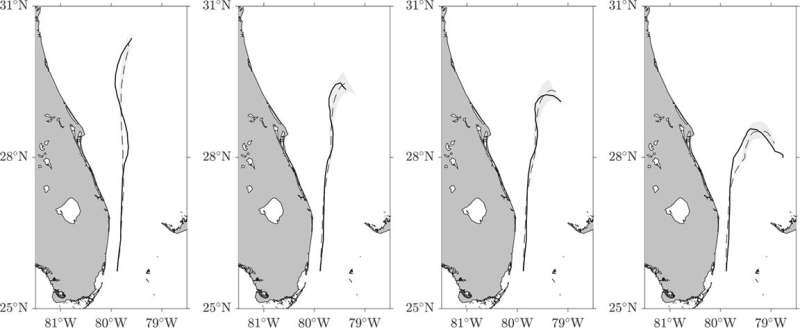Simulations show effects of buoyancy on drift in Florida Current

Acquiring a better understanding for how objects drift in the ocean has importance for a wide range of uses, like tracking algae, predicting the locations of wreckage and debris and better focusing how to clean up ocean litter. Most ways researchers model such movements have largely been put together piece by piece and lack a systematic approach. One new effort looks to provide a clearer alternative.
Researchers have released the results from an experiment aimed at tracking different objects as they drift in the Florida Current, a thermal ocean current that flows from the Straits of Florida around the Florida Peninsula and along the southeastern coast of the United States before joining the Gulf Stream Current near Cape Hatteras. Using satellite data, the group developed a new model for how objects drift based on the results and has been able to keep tabs on four types of custom buoys or drifters for one week.
Lead author Maria Josefina Olascoaga said she and her group are among the first to apply the Maxey-Riley framework to the field of oceanography and see its broad implications for many branches of ocean science. They discuss their work in this week's Physics of Fluids.
"Currently, there are efforts aimed at cleaning up mostly plastic litter in the ocean," said Olascoaga. "The success of those efforts would strongly benefit from our work, as it provides means for effectively designing cleaning strategies by allowing one to better identify the regions within the great garbage patches where litter congregates."
Determining how objects move in a flowing fluid has been notoriously difficult. After nearly a century of research, the Maxey-Riley framework was offered in the 1980s for solving for the fluid flow equation with moving boundaries and has become a major tool in studying particle motion in fluid dynamics.
In December 2017, researchers released cuboidal, spherical, plate-shaped and mat-shaped designed drifters into the waters off the coast of Florida, each about 1 cubic foot large and outfitted with a GPS tracker that pinged satellites every six hours.
The mat-shaped special drifter was designed to mimic the properties of sargassum, a macroalgae that has been implicated in foul odors, water supply discoloration and metal rusting on the shores of the Caribbean.
The group focused on how several variables affected each buoy's inertia over time, including radius, shape, buoyancy and immersion depth. From there, they found that a buoy's buoyancy had the greatest effect on its trajectory in the ocean.
Olascoaga hopes the group's work inspires others to use experimental data to model the world's oceans. The group hopes to further explore the movements of sargassum macroalgae.
More information: "Observation and quantification of inertial effects on the drift of floating objects at the ocean surface," Physics of Fluids, DOI: 10.1063/1.5139045
Journal information: Physics of Fluids
Provided by American Institute of Physics




















